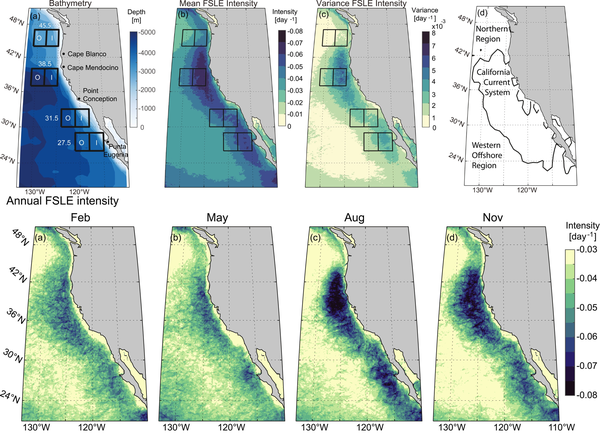Filaments in the California Current
Image of the Month - July 2022

Mean FSLE intensity for different months over the entire 25-year period (bottom). Finite size Lyapunov exponents (FSLE) intensity starts to increase near the coast in May and broadens in spatial extent and intensity until September, before decreasing again. (Credit Scripps Institution of Oceanography)
Upwelling systems on the Eastern boundaries of oceans are areas of high oceanic productivity. The winds drive nutrient-rich water stirring from depth into the euphotic zone, close to surface, thus stimulating primary production. Those areas are usual fisheries grounds, and biological hotspots. The California Current System, off the Pacific coasts of Canada, United States, and Mexico, is one of such systems. It shows seasonal variations, in phase with wind shifts.
To better understand the dynamic of the upwelling and its variability including in stirring, satellite Chlorophyll-A data can be used, but they are highly sensitive to clouds. Altimetry is not, and FSLEs provide with a possibility of reaching the same kind of resolution with an information in correlation with it. FSLEs show areas of high horizontal convergence characteristic of fronts, filaments, and the edges of eddies. Thus, FSLEs serve as both a measure of stirring in the ocean and as a measure of mesoscale activity.
Comparing 25 years of altimetry-derived FSLEs with chlorophyll-A, and also with climate indices (ENSO, PDO, etc.) in the California Current System area show that the annual cycle of mesoscale stirring is highly correlated with seasonal upwelling in a meridional band 200–600 km offshore. This is consistent with the hypothesis that increased horizontal stirring increases the export of chlorophyll-A to offshore waters.. Interannual variations show lags of varying length with the climate indices; the inflow from the North Pacific Current into the California Current System might be the source of this.
See also:
- Image of the Month, July 2016: Elephant seals and macaroni penguins follow threads
- Image of the Month, December 2009: Understanding marine areas using satellites
- Image of the Month, September 2009: Birds track ocean eddies
- Image of the Month, October 2008: Thread-like structures extracted from altimetry
- Applications: Oceanography / multi-sensors
- Applications: Oceanography / submesoscale
- Applications: Biology
- Data: FSLE - Maps of Finite Size Lyapunov Exponents
Reference:
- Giddings, A., Franks, P. J. S, & Baumann-Pickering, S. (2022). Monthly to Decadal variability of mesoscale stirring in the California Current System: Links to upwelling, climate forcing, and chlorophyll transport. Journal of Geophysical Research: Oceans, 127, e2021JC018180. https://doi.org/10.1029/2021JC018180




